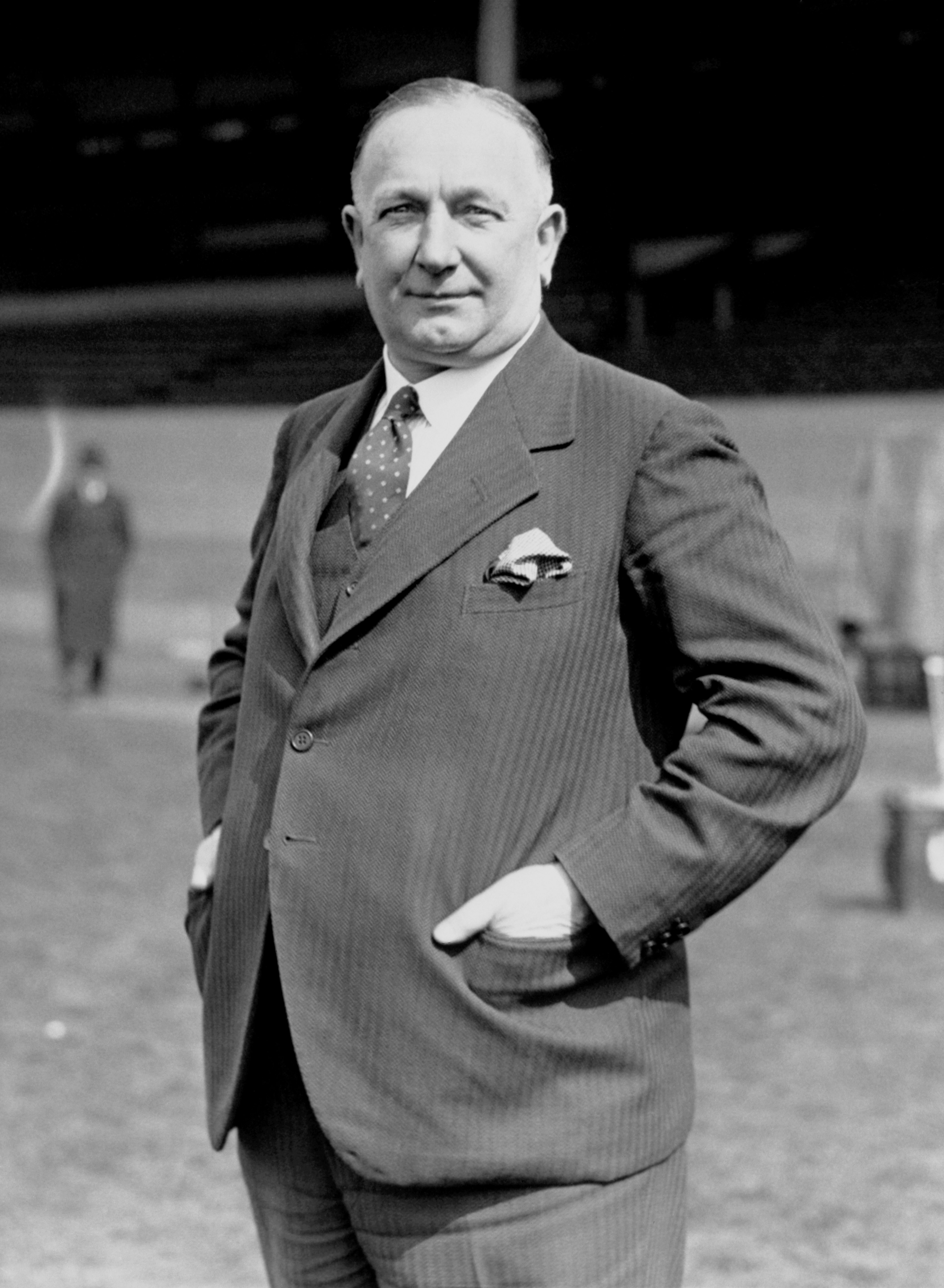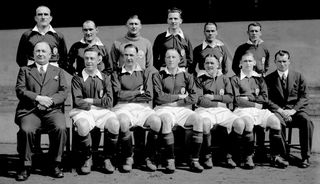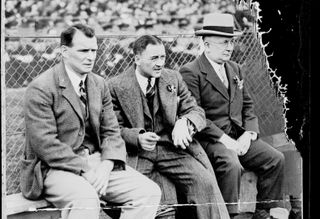What Herbert Chapman did for Highbury
Jon Spurling assesses the impact of Arsenal's influential genius...

In order to appreciate the extent of Herbert Chapman’s Highbury vision, it’s important to consider the profile football had in the early 1930s.
The media saturation of the sport, so prevalent in the modern era, simply wasn’t present. Neither did football have a stranglehold over working men. In those far-off days, speedway was a major contender and big meetings could regularly pull in crowds of 30,000 or above.
Chapman didn’t care for speedway, describing it as a “noisy and uncomfortable experience” in his Express column. Yet with only an estimated 10% of the nation in ownership of a car or motorbike at that time, speed and engines had a genuine fascination for large segments of the population at the time. So did greyhound racing, and at the White City, crowds of over 50,000 gathered. Chapman continued to argue that in the long term, football would outstrip its sporting rivals, but in the meantime, he realised that the product needed to be sufficiently attractive to pull in the punters.
After the FA decided to ban Norris from football for good, Chapman was free to build his “dream team” without Sir Henry’s tiresome influence.
Get FourFourTwo Newsletter
The best features, fun and footballing quizzes, straight to your inbox every week.
He also realised that disposable cash among many supporters was short, and apart from capturing the signature of a host of stars, good facilities at Highbury were needed to keep attendances high. “We can’t take our fans for granted you know,” George Male recalled Chapman saying in the late 1920s. “Herbert knew that he needed to give them something extra. Arsenal had a hard core of about 20,000 fans, who would generally turn up whatever. The rest needed something more. Chapman realised that the club needed to excel not just on the pitch – but also in crowd comforts.”
The biggest problem with Highbury in the early 1930s was that three sides remained uncovered. Arsenal fan Brian Kilbride recalled: “Rain was the biggest thing to affect crowds in the '30s. People generally don’t mind freezing to death, but getting soaked was another matter. Crowds could veer from between 70,000 to 20,000, and you’ll find that they often fell if it was raining.”

Via Chapman’s guiding hand, Highbury quickly became the most talked about – and modern – stadium in Europe. At a cost of £45,000 the West Stand (complete with 4,100 seats) was opened in December 1932. Brian Kilbride comments: “That stand being built made all the difference, because it replaced the huge, open terrace on the West side, which left you open to the elements. It also ensured that more of the crowd noise stayed inside Highbury. Beforehand, a lot of it would disappear upwards.”
The phenomenon provoked controversy in the Highbury district – and beyond. Islington resident Nigel Franks wrote to the Gazette and questioned “…whether such an outrageous fee can be totally justified. It seems virtually immoral at a time of national crisis that such a sum could be lavished on a football stadium.” George Male commented: “Chapman’s response to the doubters was to point out that Arsenal’s crowds bankrolled the expenditure. Critics seemed to think that taxpayers’ money went into the building of the stands. It came from turnstile receipts and generous directors.”
Chapman didn’t simply advocate the construction of larger stands. Aware that the West Stand had taken away standing space, the club decided that the Laundry End should be “banked up,” by asking local tradesmen to dump rubbish into holes at the back to extend it further. Brian Kilbride recalled: “…all sorts of carts darting to and from the back of the stand. It was reminiscent of 1913 again, when Highbury was first being built.”
The legend of the Highbury horse has now passed into folklore. The story went that a horse backed so close to the North Bank that both the animal and the cart toppled in. Dan Brennan, in his Official Arsenal Miscellany, points out that no such archaeological evidence was found when the old North Bank was demolished in 1992. Brian Kilbride cast further evidence on this urban myth: “The story went around the area for some days about the fact that some chap had lost his cart and his horse. It later emerged that a grocer from Finchley had put this story around. He was known to be a teller of tall stories. But that’s all it was. Pure pub talk. It would be nice to think it was a true story, but it wasn’t!”
It was the completion of the luxurious East Stand (“a building of wonder and unparalleled in football” in the words of the official Arsenal programme) which made Highbury the most famous ground in the world. Its art-deco frontage simply set the ground apart from others. Travelling supporters and visiting players were in awe of setting foot near Highbury.
It was the completion of the luxurious East Stand which made Highbury the most famous ground in the world
Middlesbrough striker Wilf Mannion played regularly at Highbury in the 1930s: “You’d see the front of the stadium, and straight away you’d feel a bit inferior. It was such a difference with Ayresome Park, which always seemed to be falling down from the minute it was built! Highbury was swish and awesome. You’d walk into the East Stand and the commissioner would doff his cap at you – not something which usually happened to players of my era.
"The dressing rooms in the East Stand were beautiful – the marble baths, the under-tile heating. It was pure luxury. You have to remember that this was in an era when a lot of clubs would deliberately leave the heating off in winter, or turned it up high in the summer to unsettle you. It said so much for the Arsenal that they provided for your every need. I’ll always remember the white towels laid out for us after games, and even the beer and sandwiches afterwards were of the highest quality. Arsenal had the class to treat all opponents as equals.”
Huddersfield fan Tommy Williams also made the pilgrimage to Highbury whenever his team played Arsenal: “To a lad who worked in a factory in a smoggy old town like Huddersfield, visiting Highbury in the 30s was the equivalent of going to see the Pyramids, or the Taj Mahal. My pal Eddie and me used to stand in front of the East Stand and gaze in wonder. It was gleaming white. Brand spanking new. Beautiful. Then, we’d wait for the Arsenal team to arrive. They’d stroll through the crowds, and even though all footballers supposedly earned the same at the time, you could tell they were a different breed from our lot.
"I recall that Eddie Hapgood always seemed to have a permanent suntan and he radiated health. Then he’d disappear into this heaven where the commissionaire almost bowed at the players. It was almost unreal. You could have written a soap opera about it. It was like Dallas or Dynasty – a different world. My team Huddersfield had dominated the previous decade, so I suppose I should have been annoyed that Arsenal now took their place. But the Highbury of the 1930s was a fantasy world. It was the setting for a team like that.”

Matters also improved for those standing on the Laundry End in 1935. Chapman saw to it that a roof was erected to shelter them from the elements. Brian Kilbride recalled the banter between the Laundry End’s “innies” and “outies” in the 30s. “We used to call those fans who stood under the roof softies. We were the hard lads who stood in the wet weather whatever the opposition. Looking back, I suppose that we were the stupid ones. But putting the roof on the Laundry End often meant there was a rush to get to games early. You’d have people under the roof from midday some days if rain was in the air – laughing at those who didn’t get some shelter in time.”
Not content with introducing the latest architectural designs, Chapman tried to add in a few mod cons. In 1932, he advocated the use of a giant 45-minute clock, so the crowd could see precisely how much time was left in each half. “Chapman knew that football was an event, and he wanted fans to be part of the game. He believed that a clock would add to the tension of the game, with countdowns adding to the atmosphere,” explained George Male. The FA didn’t buy into Chapman’s way of thinking and banned the mechanism, claiming it would place referees under pressure. They did finally allow the famous clock on the South Bank. “So the fans could count down anyway,” Male added sarcastically.
In 1932, he advocated the use of a giant 45-minute clock… but FA didn’t buy into Chapman’s way of thinking and banned the mechanism, claiming it would place referees under pressure
Some locals remained adamant that turning Highbury into a football mecca was unjustified. George Male recalled: “Some of us received letters from angry locals. I’m sure that Chapman did too, but he never told us. The gist was that times were hard in London, and it was distasteful that Arsenal were spending so much on a fancy stadium, when the working man was going through the Depression. They had a point – but the projects were hardly vulgar – because it was paid for by success on the field. Speculating to accumulate. That’s good business in anybody’s language.”
Chapman’s big-money purchases always seemed to coincide with another piece of bad news for Britain. In the week that David Jack arrived from Bolton for a record £10,000, the press announced an alarming downturn in the fortunes of the building trade. As he swooped for Cliff Bastin, Britain’s unemployment level reached an all-time high. The newly nicknamed “Bank Of England” club needed to pull in 40,000 punters to every home game in order to break even. It was a tall order as the Depression started to bite London. Yet his gamble would pay off.
There was always a contradiction lying at the heart of Chapman. As Huddersfield manager, he frequently reiterated the fact that spending large sums of money on players or stadiums was “a regrettable part of football.” He also believed that the status of footballers as professionals should preferably be avoided. Yet no other manager spent so much (comparatively) on players or ground improvements until the Premiership era dawned. George Male claimed: “Above all, Chapman was a showman. Everything – spending money included – came second to his team putting on a fantastic show.”
As Gunners fans from the era testify, there was no finer performance in London in the 30s than watching Arsenal play at Highbury.
Jon Spurling is a history and politics teacher in his day job, but has written articles and interviewed footballers for numerous publications at home and abroad over the last 25 years. He is a long-time contributor to FourFourTwo and has authored seven books, including the best-selling Highbury: The Story of Arsenal in N5, and Get It On: How The '70s Rocked Football was published in March 2022.
